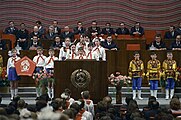Young Pioneers (Soviet Union)
The Vladimir Lenin All-Union Pioneer Organization,[a] abbreviated as the Young Pioneers, was a compulsory youth organization of the Soviet Union for children and adolescents ages 9–14 that existed between 1922 and 1991.
Vladimir Lenin All-Union Pioneer Organization
Всесоюзная пионерская организация имени Владимира Ленина
19 May 1922
28 September 1991
Moscow, Soviet Union
Structure[edit]
Its main grouping of members until 1942 was the "Young Pioneer detachment," which then typically consisted of children belonging to the same secondary school.
From 1942 to October 1990 (when the organization was broken up) the "squad" (отряд) was made up of children belonging to the same class within a school, while a school was referred to as a "Young Pioneer druzhina." Larger squads were split into sub-units called zveno (Звено, literally "chain link").
There was also an age-scale structure: children of 10–11 years were called Young Pioneers of the first stage; children of 11–12 years were Young Pioneers of the second stage; young adults of 9–15 years were Young Pioneers of the third stage. Aged 14, Young Pioneers could join the Komsomol, with a recommendation from their Young Pioneer group.
The main governing body was the Central Soviet of the Young Pioneer organization of the Soviet Union, which worked under the leadership of the main governing body of Komsomol.
Its official newspaper was Pionerskaya Pravda.
Awards[edit]
The Young Pioneers who excelled in academic study, work, sports or social activity were elected to the self-governing institutions, were sent as delegates to the Young Pioneers gatherings (including All-Union ones). The most notable were recognized in the organization's Book of Honor. During World War II, many Young Pioneers fought against Nazis in partisan detachments and/or Party underground units, which existed near their homes on territories occupied by Nazi Germany and their allies, while Pioneers in areas away from enemy lines helped in the home front efforts. Nearly 30,000 of them were awarded various orders and medals; four Young Pioneers became Heroes of the Soviet Union. One of the famous young pioneer All-Union camps was "Artek" located in Crimea opened in the 1930s. The camp was located on the top of the mountain "A-yu-dahg" which means "Bear's Mountain". Only the best students were selected to go there based on their grades and leadership. Young communists from other countries were welcome as well.
In popular culture[edit]
In the 1935 live-action animated film The New Gulliver (a Communist retelling of Jonathan Swift's classic novel), the framing story takes place at the Artek Young Pioneer camp, and the main character, Petya Konstantinov is an exemplary Pioneer boy.
The 1936 musical composition Peter and the Wolf written by Sergey Prokofiev is about a Young Pioneer called Peter who captures a wolf.[9][10]
The 1964 satirical comedy film Welcome, or No Trespassing, directed by Elem Klimov, takes place in a Young Pioneer camp.
The 1972 stop motion animated film Cheburashka features a group of Young Pioneers, and the titular character and his friend, Crocodile Gena decide to become Pioneers themselves.





